
- Source: L’OFFICIEL
- Author: Kat Herriman
- Date: October 19, 2020
- Format: PRINT AND DIGITAL
These Artists are Keeping Love Alive
There are more romantics in contemporary art than they tell you.
L’OFFICIEL LOOKS TO THE WORK OF BUNNY ROGERS, TOREY THORNTON, ANDRA URSUTA, AND DOREEN CHAN, EXAMINING THE VULNERABILITY THAT COMES WITH MERGING YOUR RELATIONSHIPS AND YOUR ART.
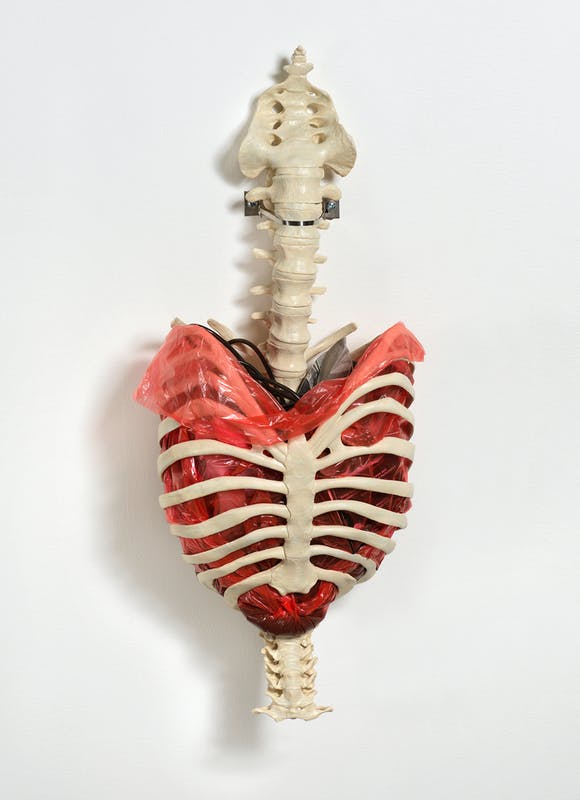
“Divorce Dump,” 2019 by Andra Ursuta. Courtesy of the artist and David Zwirner.
Very few artworks touch the emotional register that Nan Goldin’s seminal slideshow and book, The Ballad of Sexual Dependency (1986), hits. A tour de force, Ballad is a visual memoir that documents both the grizzly and glamorous truths about being in love and falling out of it. The scenes that compromise the volume are extreme in their intimacy. In them, we see the photographer in bed with friends and her lover; we also see her before the mirror taking account of the bruises he leaves on her face. I could barely look at some of them, and yet these impossible fractions added together form what I consider to be one of the most important double portraits of the era. A pioneer of this kind of explicit self-exploration, Goldin’s The Ballad of Sexual Dependency sits amongst a halcyon of work from the 1980s and ‘90s toying with autofiction-like tendencies. For proof, a list of masterpieces including but not limited to: Jeff Koons and La Ciccolinas’ pornographic Made in Heaven series, Tracy Emin’s blackbook-turned-tent sculpture Everyone I Have Ever Slept With 1963–1995, Sophie Calle and Greg Shephard’s filmic rocky road epic No Sex Last Night (1996), and Glenn Ligon’s missed-connections-like plaque project, Lest We Forget (1998).
However in the post-9/11 aughts, the winds changed. This confessional mode began to disappear from contemporary art’s mainstream in order to make room for the rise of a new desire—one tied to the art market rather than its content. Decorator-friendly movements swooped into the early 2000s, steering the spotlight away from personal narratives towards work that lent itself to more open-ended, and ultimately, more benign readings. There are the minimalists of this era, the Wade Guytons and Carol Boves, the Post-Internet conceptualists whose sleek essentialism makes it all but impossible to see the individual on the other side. There are also the maximalists: The Walter Robinson-coined Zombie Formalists like Dan Colen, Joe Bradley, and Katharina Grosse, who (collectively although perhaps not intentionally) charted a monoculture of process-based abstraction in which all meaning lives at the mercy of pareidolia. Things continued this way for almost a decade until 2010, when a newly-minted social media platform made documenting and sharing one’s life as integral as living it.
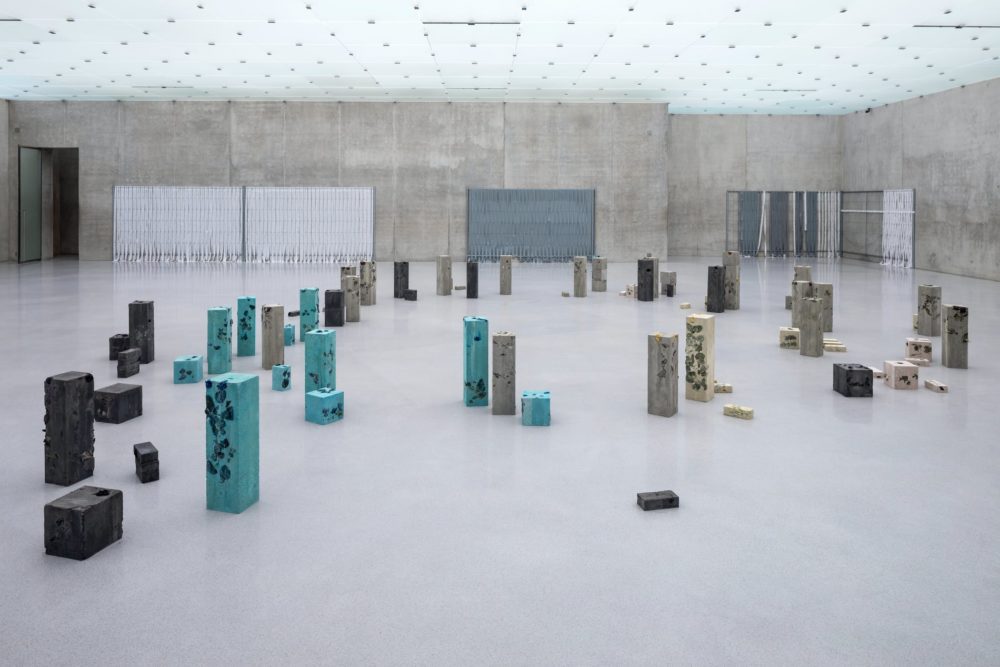
“Cement Garden,” 2020, by Bunny Rogers. Photo: Markus Tretter.
I got an Instagram account in 2011; the same year my two of my favorite works of art were born: Frances Stark’s My Best Thing and Jordan Wolfson’s Animation, masks. I would guess it’s not a coincidence. Both milestone works for their creators, these animated videos translate real episodes from the artists’ respective love lives into scripts. I like to think of them as art’s answer to authors like Rachel Cusk and Ben Lerner because as the viewer we are no longer in the position of possibly observing the archived receipts of love as in Goldin’s The Ballad of Sexual Dependency or Koons’ Made in Heaven, but experiencing the relationship as a holistic reality. This mode of storytelling makes it harder to maintain strict boundaries between ourselves and the author. The further we go, the more we are subsumed and implicated by their POV narrative.
I experienced this same sensation in sculptural form years later in Torey Thornton’s 2018 Jeffrey Stark show, Sir Veil’s Faux Outing, which converted the entire small Chinatown storefront into a giant bed. Once you climbed into the gallery, you were immediately confronted by a reflective panel into which the artist had embedded photographs of other bedrooms. Fully visible to all those who passed the glass storefront, the installation forced you to consider all the beds you’d occupied, literally and metaphorically, and who you’d shared them with. “The bed is a vehicle for a few things but initially I was thinking about business relationships, especially that intimacy between artists and how the ins-and-outs of this type of closeness is not often spoken about,” Thornton tells me. “Of course though, when you invoke the bed, you inevitably rub up against sex, but that’s where it gets interesting. I don’t think intimacy is interesting alone, but engaging with these kinds of close relationships in my work allows me to use our shared shyness to get a place where I can talk about everyone at once because these are actually universal experiences.”
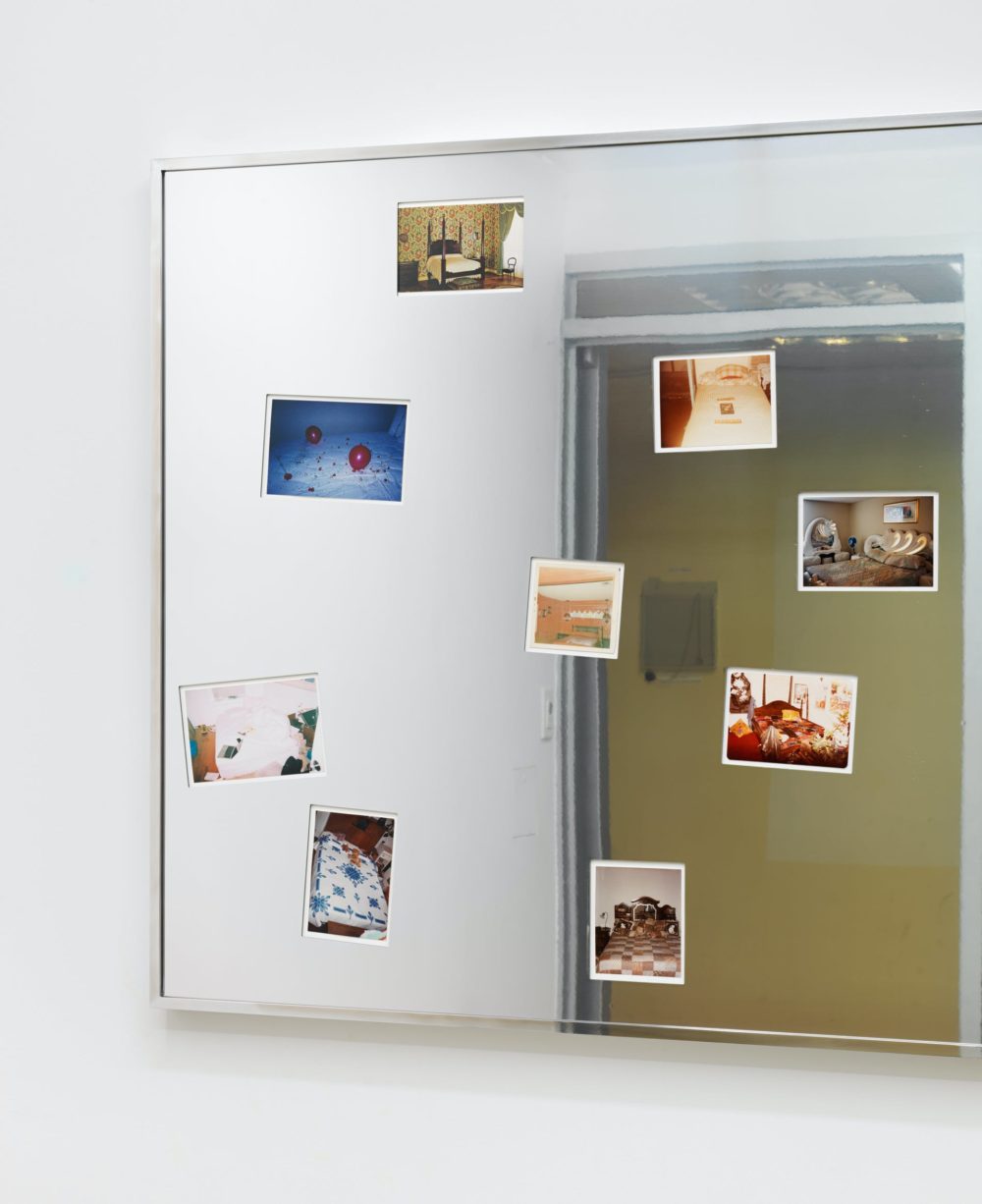
“Voyeur’s Chameleon (The Rest),” 2017-2018, by Torey Thornton.
The universality of love lost as a communal experience serves as the main chakra for Kind Kingdom, Bunny Rogers’ recently closed solo exhibition at Kunsthaus Bregenz in Austria. Unfolding across four floors of the Peter Zumthor-designed museum like a video game, Kind Kingdom takes the shape of an elaborate mourning ritual in which the viewer passes through several stages to emerge transformed on the other side.
The first floor is an imagined funeral for the artist, replete with generous floors and mood lighting. The second floor is the afterparty that follows, or at least the remains of it. A real blanket of grass has been put down to die in the windless expanse, and then covered in what looks like the remains of a rowdy collegiate get together, an aesthetic the artist describes as a “personal shipwrecking.” A kind of crime scene, Rogers’ stylized refuse offers the viewer a confetti of signifiers drawn from both the artist’s life and ‘90s news cycles. Among the plastic garbage bags, Princess Diana’s tragic death, and the pop cultural phenom that was Leonardo DiCaprio’s role in Titanic, but if you look closely you’ll notice more specific artifacts, like a destroyed office chair, which in the materials is listed as belonging to Rogers’ ex. Kind Kingdom’s garden-level tableau reminds me of Karen Kilimnik’s early scatter art installations, except in Rogers’ work, any meaning derived from the Relational Aesthetics reading must also take into account the piece’s diaristic gravity.
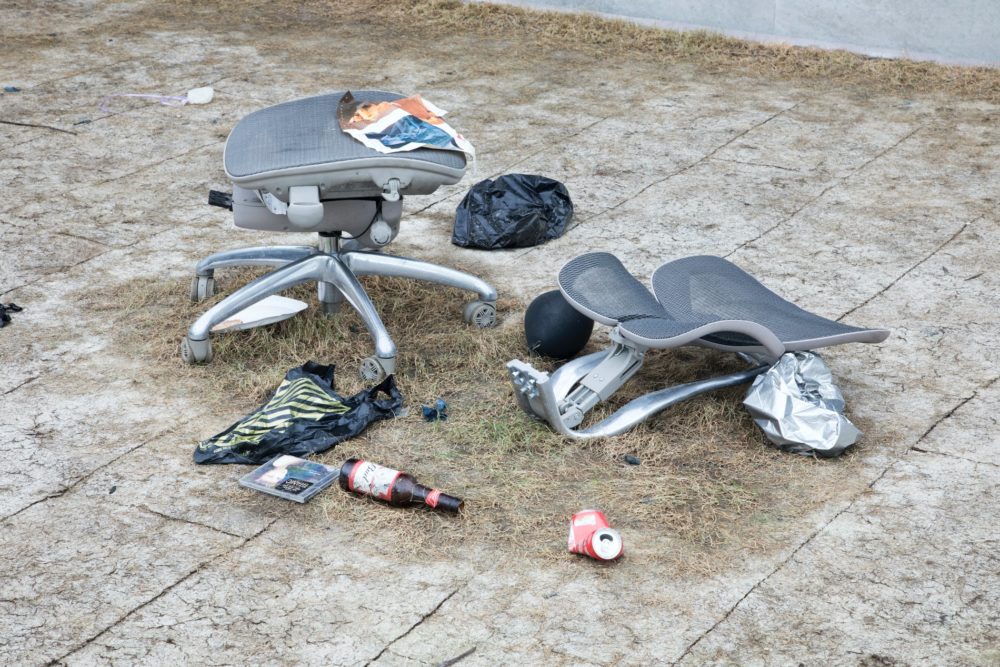
“Trash Mound,” 2020, by Bunny Rogers. Photo: Markus Tretter.
The same could be said of “Divorce Dump” (2019), Andra Ursuta’s contribution to the last Venice Biennale. Installed in the central Giardini pavilion, this wall-mounted sculpture features a series of garbage cans made from inverted models of human rib cages—the contents of which, as the title suggests, include actual souvenirs from the artist’s failed marriage. “Marriage trash,” as it is listed in the materials, is defined here as everything from a taxidermied alligator face to what looks to be pleasantly worn-in tee. By putting these loaded artifacts on display for the world to see, the artist turned herself inside out. However, like the work of Thornton, Wolfson, and Stark, “Divorce Dump” doesn’t really function as an effective peephole into Ursuta’s life, but instead as a visual shortcut to a larger conversation about that uncanny moment where an object transforms into a time machine.
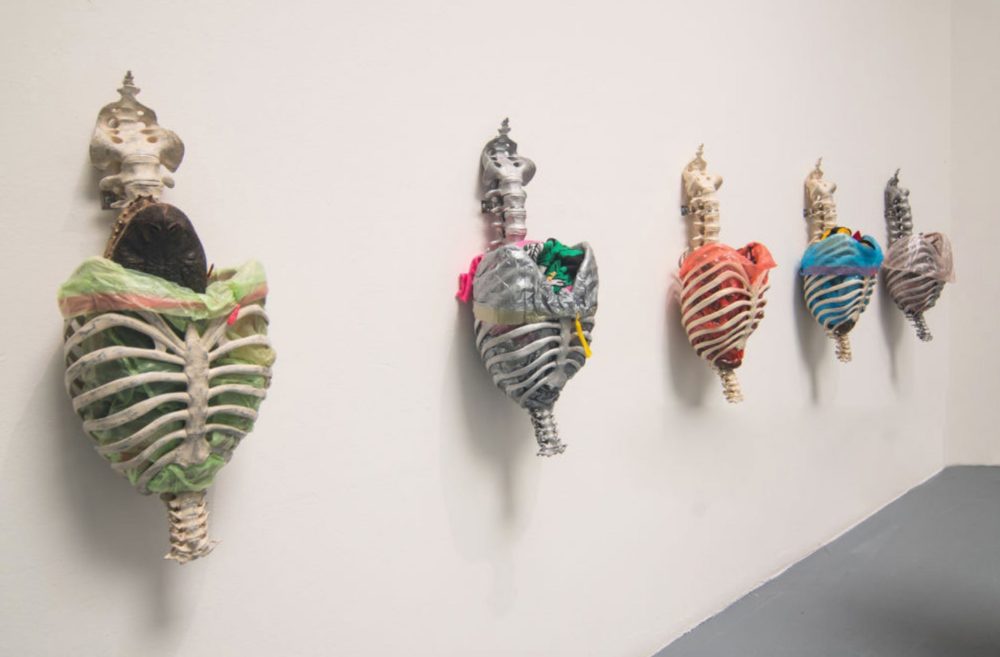
“Divorce Dump,” 2019 by Andra Ursuta. Courtesy of the artist and David Zwirner.
I remember observing this piece in the Giardini only in passing, as at the time I was in full crush, having doused my doubts of the previous summer in Aperol Spritzes. Ursuta’s offering of heart-wrenching disaster felt so far from my experience that the weight of its message didn’t hit until a year and some change later, when artist Diamond Stingily reminded me of this inverted message while on the phone. Even looking at documentation of “Divorce Dump” on David Zwirner’s website makes my stomach flip—as I think about the time my partner misplaced a stranger’s small heart necklace amongst my things.
Unrequited love is one small step away from obsession…The stalker and the lover are closer than you might think.
Objects aren’t just time machines. They can be triggers too, and in the best case, tools, as Doreen Chan teaches me. Chan doesn’t necessarily make work about her private life, but for her 2019 solo exhibition, Hard Cream, the artist transformed the HB Station Art Project Lab No.24 in Guangzhou into an approximate model of an apartment she used shared with her ex at the encouragement of Para Site Curator Qu Chang. “Our relationship felt like it grew inside my body and when I finally decided to cut it, it bled and bled. As I was beginning to prepare for Hard Cream, it was beginning to heal, but that show was about pushing my finger in the scar and awakening those memories,” Chan acknowledges by phone. “I had to push myself into that emotion in order to generate. It’s kind of dangerous for my well being, but I tried not to think too much about the repercussions because I know this kind of work can connect people who have similar heartbreak experiences and I believe that’s what makes my work potentially meaningful.”
In Hard Cream, the biographical elements that spurred Chan are all but invisible. In the end, the exhibition is not about airing dirty laundry of a past relationship or counting grievances, but instead using the artist’s experience as a case study. The goal? To find out how romantic relationships inscribe themselves as patterns on top of our environments and daily rituals, and how those textures in turn shape and break us.

”Happy,” 2019, by Doreen Chan.
There are benefits to playing guinea pig, as Chan learned. The first work that came into focus when planning Hard Cream is a short video called Happy (2019), which served as an entryway to the show. Inspired by the numerous traditional treats the artist had to assemble to impress her partner’s family over countless birthdays and celebrations, Happy features footage of the artist slowly removing tropical fruits from a whipped cream cake played in reverse. As a first time viewer, it appears as if the artist is making the dessert rather than destroying it, but then footage loops and the Sisyphean task of pleasing becomes clear. The artist’s subtitles for the work is “We never need a cake.”
And what did filming Happy taste like? Could it be sweet revenge? “Not exactly, but it was definitely a satisfying high creating that video, I felt a flush throughout my body,” Chan says. “I think in general the show for me was about digesting and healing myself, and in some cases that process manifested physically.”
Chan’s answer makes me think of Audre Lorde, who asserts in I Am Your Sister: “Art for art’s sake doesn’t really exist for me, but then it never did. What I saw was wrong, and I had to speak up. I loved poetry and I loved words. But what was beautiful had to serve the purpose of changing my life, or I would have died. If I cannot air this pain and alter it, I will surely die of it. That’s the beginning of social protest.” In Lorde’s view, romance and artmaking are entangled, and inextricable from daily life, politics, philosophy, and the other valences of individual experiences. This is the vision of art I see being currently built out by my peers—a landscape in which the artist leans into individual responsibility, preference, and experience as a way to unleash moments of shared empathy and understanding.
If you merge your relationships and everything else into your art—what is left for you?
Curator Qu Chang of Para Site sees the value in studying this kind of work as not limited to itself, but as a model for better understanding the world around us and what we are attracted to. A self-proclaimed romantic, Qu’s specialty is unrequited love, which she utilized as a central theme for Crush, a well-received group show she staged in 2018 at the influential Hong Kong artspace. When we speak about the exhibition, Qu reveals that Chris Kraus’ I Love Dick was a major source of inspiration because of the way that novel showcases how easily good intentions and loving feelings can slide into perversion and destruction. “Unrequited love is one small step away from obsession, a difference that pop culture tends to exaggerate for its own entertainment,” Qu tells me. “But the stalker and the lover are closer than you might think. Once you start looking for it, obsessive love is more or less ubiquitous in our culture, from current calls for unquestioned nationalism to the romantic repackaging of consumer goods. And oddly, while we are quick to condemn each other for being perverts, we are constantly introducing and promoting these sharing these kinds of relationships—whether as a producer, consumer, lover, or friend.”
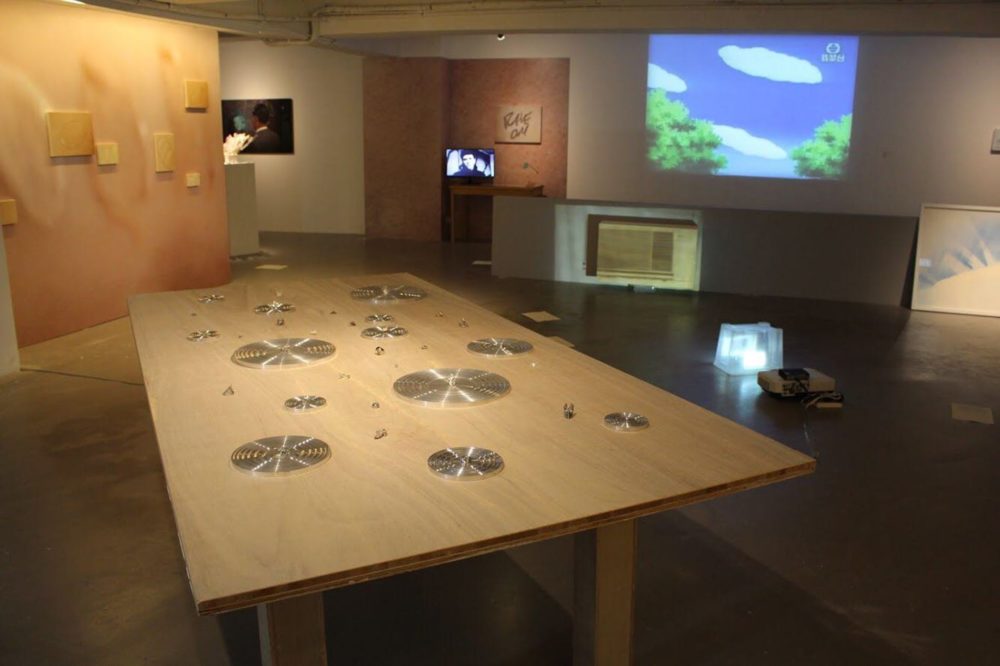
'Crush' exhibition at Para Site, Hong Kong, 2018. Photo: Para Site.
On reflection, I’m proud to be part of a generation willing to put themselves out there not as an exercise in biographic disclosure but as a means to commonality, especially after a childhood sheltered by the anonymity of usernames and virtual avatars. Because there is a cost to be paid when making work in this way, as Thornton reminds me: “Art is already so personal and in just making it you give so much to it, and expose yourself in a vulnerable way. If you merge your relationships and everything else into your art, what is left for you?” Thornton asks. “There are times where I’ve done stuff, disclosed certain realities of intimate situations, but once you go that way, it’s hard for you to live freely. You open yourself up to talking about the things no one else talks about, in the hopes that they might.”

